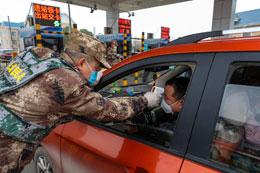Wuhan virus : ‘the worst is yet to come’

As countries across the world scramble to protect their populations from coronavirus infections, that originated in a Wuhan food market in China, researchers are warning that the worst is yet to come.
The researchers, are predicting “epicenters of self-sustaining epidemics” in Chongqing, Beijing, Shanghai, Guangzhou and Shenzhen saying the outbreak could peak around April or May in these major Chinese cities.
“Chongqing is expected to have the largest epidemic,” said Gabriel Leung, the chair of public health medicine at the University of Hong Kong.
The number of people infected with the SARS-like form of coronavirus in Wuhan, China could already be more than 30 times higher the official tally, the researchers in Hong Kong have warned.
Leung, said at a press conference that his team’s research models show that some 44,000 people in Wuhan alone—where the virus is believed to have originated in a seafood market—may be infected as of last Saturday.
Other estimates by researchers who have modeled the spread of the infection—including a team at Imperial College London—have also suggested infections are many times higher than official numbers, said Time.
Leung said that his research had been sent to Hong Kong and Beijing authorities and the World Health Organization, warning officials across the world to prepare for the worst.
“We have to be prepared that this particular epidemic may be about to become a global epidemic,” Leung said. “This is not a certainty by any stretch of the imagination, but there is not insubstantial probability that this might happen.”
The death toll from the outbreak topped 100, with more than 4,500 cases in the mainland early this week.
More than a dozen countries around the world, including Canada, have confirmed cases of the Wuhan virus, as authorities struggle to stop its spread.
Across Asia, numerous countries have put in extra screening at airports and warned citizens to avoid travel to China.
At press time, Canada, which has two confirmed cases of the virus and is investigating 19 more potential cases, warned its citizens to avoid travel to China's Hubei province, at the heart of the outbreak.
As of early this week, Thailand and Hong Kong have each reported eight cases of infection; the United States, Australia, Taiwan, Singapore and Macau have five each; Japan, South Korea and Malaysia each have reported four; France three; Vietnam and Canada two each, and one each in Germany, Sri Lanka, Nepal and Cambodia.
Asia countries are grappling with the potential economic hit of restricting Chinese tourists in a bid to protect their populations from coronavirus infections, with some imposing screenings for all incoming travellers while others have turned to deportation or an all-out ban on visitors from China.
Malaysia and the Philippines have suspended visas for travellers from Hubei province, the epicentre of the outbreak, Thailand and Japan have vowed tougher screening at airports and called for Chinese travellers who felt sick to report immediately to authorities.
India said that its flag carrier has kept one of its 423-seater jumbo plane ready in Mumbai for the evacuation of Indian citizens from Wuhan province in China in the wake of coronavirus
The Philippines' Bureau of Immigration (BI) this week has temporarily stopped issuing visas upon arrival to Chinese nationals following the Wuhan coronavirus outbreak.
Filipinos working in and around the epicenter of the mysterious new coronavirus who wish to come home will be placed in a health facility for monitoring, Health Secretary Francisco Duque said.
Suspended flights, cancelled tours, temporary restaurant closures, and millions of people in lockdown amid an extended nationwide holiday are just some of the results of a contagious new coronavirus.
The outbreak will hit Asia Pacific economies, particularly in retail, restaurants, conferences, sporting events, tourism and commercial aviation, said Rajiv Biswas, Asia Pacific chief economist at IHS Markit.
“The rapid rise in household incomes in China has triggered a boom in Chinese tourism visits abroad, which have risen from 20 million in 2003 to 150 million in 2018. Consequently the vulnerability of many Asia-Pacific economies to a slowdown in Chinese tourism visits has increased significantly over the past two decades,” said Biswas in a note on Tuesday.
Thailand, Japan and Vietnam are among the economies that will be hit by the new Chinese travel restrictions and sharp near-term slowdown in Chinese tourist visits, Biswas said.
He said Thailand has been one of the “most notable beneficiaries of the boom in Chinese tourism,” with total annual Chinese tourist visits rising from 2.7 million in 2012 to 10.5 million in 2019. Chinese tourist spending in Thailand was estimated to have reached $17 billion in 2019.
Japan’s services industry is also getting hit by a rash of trip and hotel cancellations, the Nikkei Asian Review reported.
The country is a top vacation spot and IHS’ Biswas noted that total Chinese tourist visits to Japan hitting 9.6 million in 2019, accounting for 30% of total foreign tourist visits.
Meanwhile, Chinese tourism arrivals accounted for one-third of international visits to Vietnam, and 15% of total international tourist visits to Australia.
Biswas said governments in Asia Pacific are likely to respond with a range of fiscal and monetary policy stimulus to prop up near-term growth.









